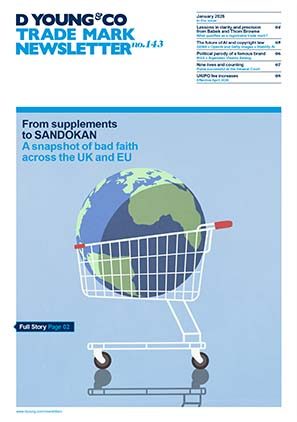Well-known marks in the UK - how brands can benefit from broader protection
The new regulation (which came into force in the UK on 27 December 2022) amends Section 56 of the Trade Marks Act 1994 to grant holders of unregistered “well-known trade marks” (as defined in Article 6bis) the right to prohibit the use or registration of a conflicting mark on dissimilar goods or services. The change also ensures UK-based right holders are entitled to the same level of protection under this provision as foreign parties.
Background
The amendment has been passed to ensure clear compliance with the World Intellectual Property Organization’s (WIPO) “Joint Recommendation Concerning Provisions on the Protection of Well-Known Marks”.
Before this change, the special protection afforded to well-known marks could only be relied upon by holders of a mark connected with a Paris Convention country, and excluded marks held by UK-based owners. In practice, UK rights holders could rely on passing off, but this requires goodwill (use) in the relevant territory.
The UK regulation also previously required a likelihood of confusion for Article 6bis to be invoked. This meant that the law was rarely relied upon in the UK.
To illustrate this point, in the House of Commons on 26 October 2022, Dean Russell (the government minister responsible for intellectual property) estimated that well-known marks were only relied on about 12 times a year in UK Intellectual Property Office (UKIPO) tribunal proceedings.
However, the new law should be more akin to a broader reputation-type protection, that is, where the contested mark is registered/used for dissimilar goods and services but, nevertheless, takes unfair advantage of the distinctive character or repute of an earlier registered mark.
Protection without UK use?
The protection of well-known marks does not require use or registration within the territory. UK law already establishes that a mark can be well-known “whether or not that person carries on business, or has any goodwill, in the United Kingdom”.
However, the requirements on level of recognition are onerous. The relevant factors for determining well-known marks will remain the same:
- the degree of recognition of the trade mark;
- the duration, extent and geographical area of any use of the mark;
- the level of promotion of the mark, for the relevant goods or services;
- the duration and geographical area of any protection of the mark (trade mark registrations or applications), insofar as it indicates use or recognition of the mark;
- track record of successful enforcement of the mark, in particular, whether the mark is recognised as “well known” by competent authorities;
- the value associated with the mark.
Clearly this is a high evidential burden and use of the mark is laced throughout a number of the relevant factors. However, minimal use, or use only in other territories, is not a determinative barrier because owners can rely on recognition and value alone, as referenced in a number of the other factors above.
Since this expansion of protection to dissimilar goods and services is only a very recent change in UK law, it is difficult to predict how it will be interpreted by the courts or the UKIPO in practice. Time will tell whether this will lead to more instances of parties successfully relying on well-known marks protection in the UK. We will be monitoring and reporting on any developments in due course.
In short
This recent change represents a welcome broadening of protection for well-known brands, bringing the UK in alignment with WIPO recommendations and other Paris Convention countries. In short, the new regulation:
- Continues to provide protection to unregistered rights even, in some cases, where there is no use within the jurisdiction.
- Gives holders of unregistered "well-known trade marks" the right to prohibit the use of a conflicting trade mark on dissimilar goods or services. Previously, this right could only be used for similar goods or services.
- Extends the provisions on well-known marks to UK based rights holders.
UKIPO guidance: changes for "well-known marks"
View the UKIPO website for its guidance on well-known marks, updated 19 December 2022.
Read more
